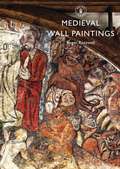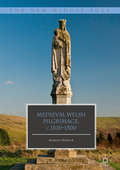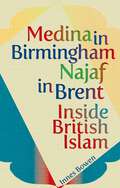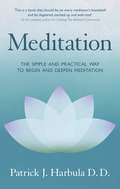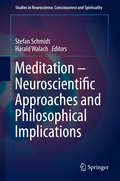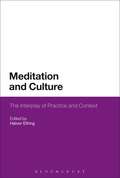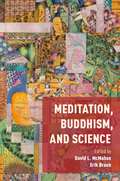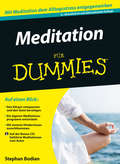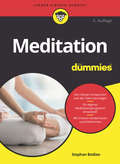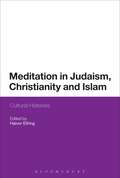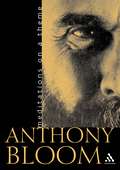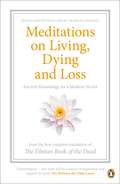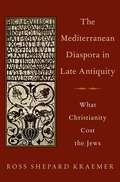- Table View
- List View
Medieval Wall Paintings (Shire Library #767)
by Roger RosewellThe medieval wall paintings that remain in English churches are for the most part shadows of their former selves – the rare fragments of this beautiful art to have survived not only the Reformation but also successive waves of iconoclastic zeal and unsympathetic restoration. The whitewashed walls of most parish churches belie the riot of colour and decoration that once adorned them, but the remnants of paintings tucked into corners or rescued from later layers of paint help us to understand the role of art in medieval religion. Roger Rosewell here offers a guide to the role played by medieval wall paintings, as religious, didactic and commemorative works of art, telling the stories of those who created them and those who used them on a daily basis. He also compares and contrasts religious and domestic wall paintings, using beautiful colour photography throughout.
Medieval Welsh Pilgrimage, c.1100–1500 (The New Middle Ages)
by Kathryn HurlockMedieval Welsh Pilgrimage, c.1100–1500 examines one of the most popular expressions of religious belief in medieval Europe—from the promotion of particular sites for political, religious, and financial reasons to the experience of pilgrims and their impact on the Welsh landscape. Addressing a major gap in Welsh Studies, Kathryn Hurlock peels back the historical and religious layers of these holy pilgrimage sites to explore what motivated pilgrims to visit these particular sites, how family and locality drove the development of certain destinations, what pilgrims expected from their experience, how they engaged with pilgrimage in person or virtually, and what they saw, smelled, heard, and did when they reached their ultimate goal.
Medina in Birmingham, Najaf in Brent: Inside British Islam
by Innes BowenMuslim intellectuals may try to define something called British Islam, but the truth is that as the Muslim community of Britain has grown in size and religiosity, so too has the opportunity to found and run mosques which divide along ethnic and sectarian lines. Just as most churches in Britain are affiliated to one of the main Christian denominations, the vast majority of Britain's 1600 mosques are linked to wider sectarian networks: the Deobandi and Tablighi Jamaat movements with their origins in colonial India; the Salafi groups inspired by an austere form of Islam widely practiced in Saudi Arabia; the Islamist movements with links to religious political parties in the Middle East and South Asia; the Sufi movements that tend to emphasise spirituality rather than religious and political militancy; and the diverse Shi'ite sects which range from the orthodox disciples of Grand Ayatollah Sistani in Iraq to the Ismaili followers of the pragmatic and modernising Aga Khan. These affiliations are usually not apparent to outsiders, but inside Britain's Muslim communities sectarian divides are often fiercely guarded by religious leaders. This book, of which no equivalent volume yet exists, is a definitive guide to the ideological differences, organisational structures and international links of the main Islamic groups active in Britain today.
Medina in Birmingham, Najaf in Brent: Inside British Islam
by Innes BowenMuslim intellectuals may try to define something called British Islam, but the truth is that as the Muslim community of Britain has grown in size and religiosity, so too has the opportunity to found and run mosques which divide along ethnic and sectarian lines. Just as most churches in Britain are affiliated to one of the main Christian denominations, the vast majority of Britain's 1600 mosques are linked to wider sectarian networks: the Deobandi and Tablighi Jamaat movements with their origins in colonial India; the Salafi groups inspired by an austere form of Islam widely practiced in Saudi Arabia; the Islamist movements with links to religious political parties in the Middle East and South Asia; the Sufi movements that tend to emphasise spirituality rather than religious and political militancy; and the diverse Shi'ite sects which range from the orthodox disciples of Grand Ayatollah Sistani in Iraq to the Ismaili followers of the pragmatic and modernising Aga Khan. These affiliations are usually not apparent to outsiders, but inside Britain's Muslim communities sectarian divides are often fiercely guarded by religious leaders. This book, of which no equivalent volume yet exists, is a definitive guide to the ideological differences, organisational structures and international links of the main Islamic groups active in Britain today.
Meditation: The Simple and Practical Way to Begin and Deepen Meditation (A\start Here Guide Ser.)
by Patrick Harbula'This is a book that should be on every meditator's bookshelf' - Dr Jim LockardAn accessible, insightful, user-friendly guide to meditation, perfect for anyone who wants to enjoy sustained and meaningful meditation practiceMeditation is an ancient practice that has brought peace and clarity to people from every time, culture and place. Its benefits - a sense of calm, greater knowledge of self, better health - are as appealing to the modern world as they were to the ancient. In this beginner's guide to meditation, author Patrick Harbula provides readers with everything they need to know in order to experience deep meditation.Readers will learn: - The history of meditation, both Eastern and Western- The benefits of meditation for the mind, body, and spirit- Different forms of meditation practice- Supportive practices to enhance the benefits of meditation in daily living.- Simple ways to begin meditation immediately, and more . . .In addition, readers will also find simple techniques to deepen the meditation path for more experienced meditators. Meditation demystifies the often times intimidating world of meditation, providing the perfect starting point for anyone looking to cultivate a sense of peace in their life.
Meditation – Neuroscientific Approaches and Philosophical Implications (Studies in Neuroscience, Consciousness and Spirituality #2)
by Stefan Schmidt Harald WalachThis volume features a collection of essays on consciousness, which has become one of the hot topics at the crossroads between neuroscience, philosophy, and religious studies. Is consciousness something the brain produces? How can we study it? Is there just one type of consciousness or are there different states that can be discriminated? Are so called “higher states of consciousness” that some people report during meditation pointing towards a new understanding of consciousness? Meditation research is a new discipline that shows new inroads into the study of consciousness. If a meditative practice changes brain structure itself this is direct proof of the causal influence of consciousness onto its substrate. If different states of consciousness can be linked with properties and states of the brain this can be used to study consciousness more directly. If the sense of self is modifiable through meditative techniques and this can be objectively shown through neuro-imaging, this has profound implications for our understanding of who we are. Can consciousness, in deep states of meditative absorption, actually access some aspect of reality which we normally don't? Meditation research can potentially foster us with a new access to the phenomenological method in general. This has even been branded with a new catch-phrase: Contemplative Science. It brings together the most modern neuroscientific approach and the most advanced phenomenological methodology of studying the mind from within, through highly skilled self-observation that has gone through many thousand hours of honing the capacity to look carefully, without distraction. This book addresses these issues by bringing together some of the leading researchers and thinkers in the field. The scope of the volume reaches from first person neuroscience to Indian philosophy, from pedagogic applications to epistemological aspects and from compassion meditation to the study of brain activity.
Meditation and Culture: The Interplay of Practice and Context
by Halvor EifringBehind the stereotype of a solitary meditator closing his eyes to the world, meditation always takes place in close interaction with the surrounding culture. Meditation and Culture: The Interplay of Practice and Context explores cases in which the relation between meditative practice and cultural context is particularly complex. The internationally-renowned contributors discuss practices that travel from one culture to another, or are surrounded by competing cultures. They explore cultures that bring together competing practices, or that are themselves mosaics of elements of different origins. They seek to answer the question: What is the relationship between meditation and culture? The effects of meditation may arise from its symbolic value within larger webs of cultural meaning, as in the contextual view that still dominates cultural and religious studies. They may also be psychobiological responses to the practice itself, the cultural context merely acting as a catalyst for processes originating in the body and mind of the practitioner. Meditation and Culture gives no single definitive explanation, but taken together, the different viewpoints presented point to the complexity of the relationship.
Meditation and Culture: The Interplay of Practice and Context
by Halvor EifringBehind the stereotype of a solitary meditator closing his eyes to the world, meditation always takes place in close interaction with the surrounding culture. Meditation and Culture: The Interplay of Practice and Context explores cases in which the relation between meditative practice and cultural context is particularly complex. The internationally-renowned contributors discuss practices that travel from one culture to another, or are surrounded by competing cultures. They explore cultures that bring together competing practices, or that are themselves mosaics of elements of different origins. They seek to answer the question: What is the relationship between meditation and culture? The effects of meditation may arise from its symbolic value within larger webs of cultural meaning, as in the contextual view that still dominates cultural and religious studies. They may also be psychobiological responses to the practice itself, the cultural context merely acting as a catalyst for processes originating in the body and mind of the practitioner. Meditation and Culture gives no single definitive explanation, but taken together, the different viewpoints presented point to the complexity of the relationship.
Meditation, Buddhism, and Science
The scientific study of Buddhist forms of meditation has surged in recent years, capturing the popular imagination and reshaping conceptions of what meditation is and what it can do. For perhaps the first time in history, meditation has shifted from Buddhist monasteries and practice centers to some of the most prominent and powerful modern institutions in the world, as well as non-institutional settings. As their contexts change, so do the practices-sometimes drastically. New ways of thinking about meditation are emerging as it moves toward more secular settings, ways that profoundly affect millions of lives all over the world. To understand these changes and their effects, the essays in this volume explore the unaddressed complexities in the interrelations between Buddhist history and thought and the scientific study of meditation. The contributors bring philosophical, cultural, historical, and ethnographic perspectives to bear, considering such issues as the philosophical presuppositions behind practice, the secularization of meditation, the values and goods assumed in clinical approaches, and the sorts of subjects that take shape under the influence of these transformed and transformative practices-all the more powerful for being so often formulated with the authority of scientific discourse.
MEDITATION, BUDDHISM & SCIENCE C
by Erik Braun David L. McMahanThe scientific study of Buddhist forms of meditation has surged in recent years, capturing the popular imagination and reshaping conceptions of what meditation is and what it can do. For perhaps the first time in history, meditation has shifted from Buddhist monasteries and practice centers to some of the most prominent and powerful modern institutions in the world, as well as non-institutional settings. As their contexts change, so do the practices-sometimes drastically. New ways of thinking about meditation are emerging as it moves toward more secular settings, ways that profoundly affect millions of lives all over the world. To understand these changes and their effects, the essays in this volume explore the unaddressed complexities in the interrelations between Buddhist history and thought and the scientific study of meditation. The contributors bring philosophical, cultural, historical, and ethnographic perspectives to bear, considering such issues as the philosophical presuppositions behind practice, the secularization of meditation, the values and goods assumed in clinical approaches, and the sorts of subjects that take shape under the influence of these transformed and transformative practices-all the more powerful for being so often formulated with the authority of scientific discourse.
Meditation für Dummies (Für Dummies)
by Stephan BodianSie hetzen von einem Termin zum nächsten, kommen nie zur Ruhe und wissen gar nicht mehr, was Erholung, innere Ruhe und Ausgeglichenheit sind? Versuchen Sie es mit Meditation. Dafür müssen Sie keineswegs zum einsamen Mönch werden, denn Meditation lässt sich auch in Ihren Alltag integrieren. Lassen Sie sich von Stephan Bodian auf diesem Weg begleiten. Er zeigt Ihnen, wie Sie durch einfache Meditationen Energie und Kraft tanken und wie Sie auch als erfahrener Meditierender mit besonderen Problemsituationen umgehen. Starten Sie Schritt für Schritt eine Reise in Ihr Inneres und finden Sie so zu mehr Ausgeglichenheit und Lebensfreude!
Meditation für Dummies (Für Dummies)
by Stephan BodianSie hetzen von einem Termin zum nächsten, kommen nie zur Ruhe und wissen gar nicht mehr, was Erholung, innere Ruhe und Ausgeglichenheit sind? Versuchen Sie es mit Meditation. Dafür müssen Sie keineswegs zum einsamen Mönch werden, denn Meditation lässt sich auch in Ihren Alltag integrieren. Lassen Sie sich von Stephan Bodian auf diesem Weg begleiten. Er zeigt Ihnen, wie Sie durch einfache Meditationen Energie und Kraft tanken und wie Sie auch als erfahrener Meditierender mit besonderen Problemsituationen umgehen. Starten Sie Schritt für Schritt eine Reise in Ihr Inneres und finden Sie so zu mehr Ausgeglichenheit und Lebensfreude!
Meditation in Judaism, Christianity and Islam: Cultural Histories
by Halvor EifringMeditative practices have flourished in widely different parts of Eurasia, yet historical research on such practices is limited. Research to date has focused on contexts rather than actual practices, and within individual traditions.For the first time in one volume, the meditative practices of the three traditions of Judaism, Christianity and Islam are examined. They are viewed in a global perspective, considering both generic and historical connections to practices in other traditions, particularly in India and East Asia. Their cultural and historical peculiarities are examined, comparing them both to each other and to Asian forms of meditation. The book builds on a notion of meditation as self-administered techniques for inner transformation, a definition which focuses on transformative practice rather than notions of meditative states andmystical experiences. It proposes ways of studying meditative practice historically, and concludes with an essay on the modern scientific interest in meditation.
Meditation in Judaism, Christianity and Islam: Cultural Histories
by Halvor EifringMeditative practices have flourished in widely different parts of Eurasia, yet historical research on such practices is limited. Research to date has focused on contexts rather than actual practices, and within individual traditions.For the first time in one volume, the meditative practices of the three traditions of Judaism, Christianity and Islam are examined. They are viewed in a global perspective, considering both generic and historical connections to practices in other traditions, particularly in India and East Asia. Their cultural and historical peculiarities are examined, comparing them both to each other and to Asian forms of meditation. The book builds on a notion of meditation as self-administered techniques for inner transformation, a definition which focuses on transformative practice rather than notions of meditative states andmystical experiences. It proposes ways of studying meditative practice historically, and concludes with an essay on the modern scientific interest in meditation.
Meditations 4: Dhamma Talks
by Thanissaro Bhikkhu<p class="description">A collection of transcribed Dhamma talks given by Thanissaro Bhikkhu on Buddhist meditation and practice.</p>
Meditations 5: Dhamma Talks
by Thanissaro BhikkhuA collection of transcribed Dhamma talks given by Thanissaro Bhikkhu on Buddhist meditation and practice.
Meditations for Mortals: Four weeks to embrace your limitations and make time for what counts
by Oliver BurkemanMeditations for Mortals takes us on a liberating journey towards a more meaningful life – one that begins not with fantasies of the ideal existence, but with the reality in which we actually find ourselves.Addressing the fundamental questions about how to live, it offers a powerful new way to take action on what counts: a guiding philosophy of life Oliver Burkeman calls ‘imperfectionism’. How can we embrace our non-negotiable limitations? Or make good decisions when there’s always too much to do? What if purposeful productivity were often about letting things happen, not making them happen?Reflecting on ideas drawn from philosophy, religion, literature, psychology, and self-help, Burkeman explores practical tools and shifts in perspective. The result is a bracing challenge to much familiar advice, and a profound yet entertaining crash course in living more fully.To be read either as a four-week ‘retreat of the mind’ or devoured in one or two sittings, Meditations for Mortals will be a source of solace and inspiration, and an aid to a saner, freer, and more enchantment-filled life. In anxiety-inducing times, it is rich in truths we have never needed more.
Meditations on a Theme
by Anthony BloomMetropolitan Anthony (Anthony Bloom) caught the imagination of countless people by his broadcasts. Their content was uncomfortable and challenging but they drew huge audiences. He then started publishing books and one of his first was was Meditations on a Theme, which we are proud to reissue.Anthony Bloom takes us on a path traced by centuries of Christian pilgrims, taking as landmarks for our meditations certain passages of the Gospel. At the close of the journey we are able to to forget ourselves as we enter a vision which transcends us and at the same time leads us to contemplate trust which alone can bring us to God.
Meditations on Living, Dying and Loss: Ancient Knowledge for a Modern World from the Tibetan Book of the Dead
by Dalai Lama Thupten Jinpa Gyurme Dorje Graham Coleman Penguin GroupThe most graceful English translation of this masterpiece of world literature - translated and co-edited by three leading contemporary masters of this tradition, appointed by the Dalai Lama himself What is death? How can I help those who are dying? How can I prepare for my own death? And how can I come to terms with bereavement?Here is an accessible and moving introduction to The Tibetan Book of the Dead, whose visionary perspective on living, dying, and loss is one of the most inspirational and compelling in world literature.With an introductory commentary by His Holiness the Dalai Lama, Meditations on Living, Dying, and Loss is a compilation of writings from the first complete translation of The Tibetan Book of the Dead, which explores these central questions. Each chapter is introduced by the editor of the acclaimed first translation, Graham Coleman. Based on his experience of bereavement and his knowledge of contemporary near-death research, he reveals the immense creativity that deepening our insight into the relationship between living and dying can bring.Graham Coleman (co-editor) is President of the Orient Foundation (UK). Thupten Jinpa (co-editor) is the senior translator to His Holiness the Dalai Lama. Gyurme Dorje (translator) is a leading scholar of the Nyingma tradition of Tibetan Buddhism. The introduction is written by His Holiness the Dalai Lama.
Meditations on the Incarnation, Passion, and Death of Jesus Christ (The Other Voice in Early Modern Europe)
by Catharina Regina von GreiffenbergRead by Protestants and Catholics alike, Catharina Regina von Greiffenberg (1633–94) was the foremost German woman poet and writer in the seventeenth-century German-speaking world. Privileged by her social station and education, she published a large body of religious writings under her own name to a reception unequaled by any other German woman during her lifetime. But once the popularity of devotional writings as a genre waned, Catharina’s works went largely unread until scholars devoted renewed attention to them in the twentieth century. For this volume, Lynne Tatlock translates for the first time into English three of the thirty-six meditations, restoring Catharina to her rightful place in print. These meditations foreground women in the life of Jesus Christ—including accounts of women at the Incarnation and the Tomb—and in Scripture in general. Tatlock’s selections give the modern reader a sense of the structure and nature of Catharina’s devotional writings, highlighting the alternative they offer to the male-centered view of early modern literary and cultural production during her day, and redefining the role of women in Christian history.
Meditations on the Incarnation, Passion, and Death of Jesus Christ (The Other Voice in Early Modern Europe)
by Catharina Regina von GreiffenbergRead by Protestants and Catholics alike, Catharina Regina von Greiffenberg (1633–94) was the foremost German woman poet and writer in the seventeenth-century German-speaking world. Privileged by her social station and education, she published a large body of religious writings under her own name to a reception unequaled by any other German woman during her lifetime. But once the popularity of devotional writings as a genre waned, Catharina’s works went largely unread until scholars devoted renewed attention to them in the twentieth century. For this volume, Lynne Tatlock translates for the first time into English three of the thirty-six meditations, restoring Catharina to her rightful place in print. These meditations foreground women in the life of Jesus Christ—including accounts of women at the Incarnation and the Tomb—and in Scripture in general. Tatlock’s selections give the modern reader a sense of the structure and nature of Catharina’s devotional writings, highlighting the alternative they offer to the male-centered view of early modern literary and cultural production during her day, and redefining the role of women in Christian history.
Meditations on the Incarnation, Passion, and Death of Jesus Christ (The Other Voice in Early Modern Europe)
by Catharina Regina von GreiffenbergRead by Protestants and Catholics alike, Catharina Regina von Greiffenberg (1633–94) was the foremost German woman poet and writer in the seventeenth-century German-speaking world. Privileged by her social station and education, she published a large body of religious writings under her own name to a reception unequaled by any other German woman during her lifetime. But once the popularity of devotional writings as a genre waned, Catharina’s works went largely unread until scholars devoted renewed attention to them in the twentieth century. For this volume, Lynne Tatlock translates for the first time into English three of the thirty-six meditations, restoring Catharina to her rightful place in print. These meditations foreground women in the life of Jesus Christ—including accounts of women at the Incarnation and the Tomb—and in Scripture in general. Tatlock’s selections give the modern reader a sense of the structure and nature of Catharina’s devotional writings, highlighting the alternative they offer to the male-centered view of early modern literary and cultural production during her day, and redefining the role of women in Christian history.
Meditations6
by Thanissaro BhikkhuDhamma talks on breath meditation and various aspects of the Buddhist Path given during the evening meditation sessions at Metta Forest Monastery from 2009-2011.
The Mediterranean Diaspora in Late Antiquity: What Christianity Cost the Jews
by Ross Shepard KraemerThe Mediterranean Diaspora in Late Antiquity examines the fate of Jews living in the Mediterranean Jewish diaspora after the Roman emperor Constantine threw his patronage to the emerging orthodox (Nicene) Christian churches. By the fifth century, much of the rich material evidence for Greek and Latin-speaking Jews in the diaspora diminishes sharply. Ross Shepard Kraemer argues that this increasing absence of evidence is evidence of increasing absence of Jews themselves. Literary sources, late antique Roman laws, and archaeological remains illuminate how Christian bishops and emperors used a variety of tactics to coerce Jews into conversion: violence, threats of violence, deprivation of various legal rights, exclusion from imperial employment, and others. Unlike other non-orthodox Christians, Jews who resisted conversion were reluctantly tolerated, perhaps because of beliefs that Christ's return required their conversion. In response to these pressures, Jews leveraged political and social networks for legal protection, retaliated with their own acts of violence, and sometimes became Christians. Some may have emigrated to regions where imperial laws were more laxly enforced, or which were under control of non-orthodox (Arian) Christians. Increasingly, they embraced forms of Jewish practice that constructed tighter social boundaries around them. The Mediterranean Diaspora in Late Antiquity concludes that by the beginning of the seventh century, the orthodox Christianization of the Roman Empire had cost diaspora Jews--and all non-orthodox persons, including Christians--dearly.
The Mediterranean Diaspora in Late Antiquity: What Christianity Cost the Jews
by Ross Shepard KraemerThe Mediterranean Diaspora in Late Antiquity examines the fate of Jews living in the Mediterranean Jewish diaspora after the Roman emperor Constantine threw his patronage to the emerging orthodox (Nicene) Christian churches. By the fifth century, much of the rich material evidence for Greek and Latin-speaking Jews in the diaspora diminishes sharply. Ross Shepard Kraemer argues that this increasing absence of evidence is evidence of increasing absence of Jews themselves. Literary sources, late antique Roman laws, and archaeological remains illuminate how Christian bishops and emperors used a variety of tactics to coerce Jews into conversion: violence, threats of violence, deprivation of various legal rights, exclusion from imperial employment, and others. Unlike other non-orthodox Christians, Jews who resisted conversion were reluctantly tolerated, perhaps because of beliefs that Christ's return required their conversion. In response to these pressures, Jews leveraged political and social networks for legal protection, retaliated with their own acts of violence, and sometimes became Christians. Some may have emigrated to regions where imperial laws were more laxly enforced, or which were under control of non-orthodox (Arian) Christians. Increasingly, they embraced forms of Jewish practice that constructed tighter social boundaries around them. The Mediterranean Diaspora in Late Antiquity concludes that by the beginning of the seventh century, the orthodox Christianization of the Roman Empire had cost diaspora Jews--and all non-orthodox persons, including Christians--dearly.
